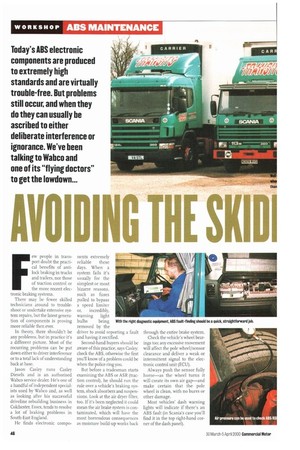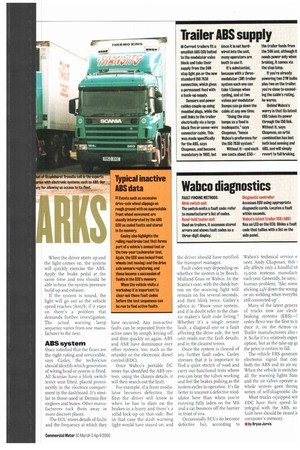IF ew people in transport doubt the practical benefits of antilock
Page 48

Page 49

If you've noticed an error in this article please click here to report it so we can fix it.
braking in trucks and trailers, nor those of traction control or the more recent electronic braking systems.
There may be fewer skilled technicians around to troubleshoot or undertake extensive system repairs, but the latest generation of components is proving more reliable then ever.
In theory, there shouldn't be any problems, but in practice it's a different picture. Most of the recurring problems can be put down either to driver interference or to a total lack of understanding back at base.
Jason Casley runs Casley Diesels and is an authorised Wabco service dealer. He's one of a handful of independent specialists used by Wabco and, as well as looking after his successful driveline rebuilding business in Colchester, Essex, tends to resolve a lot of braking problems in South-East England.
He finds electronic compo
nents extremely reliable these days. When a system fails it's usually for the simplest or most bizarre reasons, such as fuses pulled to bypass a speed limiter or, incredibly, warning light bulbs being removed by the driver to avoid reporting a fault and having it rectified.
Second-hand buyers should be aware of this practice, says Casley; check the ABS, otherwise the first you'll know of a problem could be when the police ring you.
But before a tradesman starts examining the ABS or ASR (traction control), he should run the rule over a vehicle's braking system, shock absorbers and suspensions. Look at the air dryer filter, too. If it's been neglected it could mean the air brake system is contaminated, which will have the most horrendous consequences as moisture build-up works back
through the entire brake system.
Check the vehicle's wheel bearings too; any excessive movement will affect the pole wheel/sensor clearance and deliver a weak or intermittent signal to the electronic control unit (ECU).
Always push the sensor fully home—as the wheel turns it will create its own air gap—and make certain that the pole wheel is clean, with no burrs or other damage.
Most vehicles' dash warning lights will indicate if there's an ABS fault (in Scania's case you'll find it in the top right-band corner of the dash panel). When the driver starts up and the light comes on, the system will quickly exercise the ABS. Apply the brake pedal at the same time and you should be able to hear the system pressure build up and exhaust.
If the system is sound, the light will go out as the vehicle speed reaches 7km/h; if it stays on there's a problem that demands further investigation. The actual warning lamp sequence varies from one manufacturer to the next.
ABS system
Once satisfied that the fuses are the right rating and serviceable, says Casley, the technician should identify which generation of wiring head or system is fitted. All Scanias have a blink switch tester unit fitted, placed prominently in the clectrics compartment in the dashboard. It's similar to those used in Dennis fire engines and buses. Other manufacturers tuck them away in more discreet places.
The ECU stores details of faults and the frequency at which they have occurred, Any non-active faults can be separated from the active ones by simply keying off and then quickly on again. ABS and ASR have dominance over other systems, too, such as the retarder or the electronic diesel control (EDC).
Once Wabco's portable DC tester has identified the ABS system, using the chassis details, it will then search out the fault.
For example, if a front modulator becomes defective, the first the driver will know is when he has to slam on the brakes in a hurry and there's a solid lock-up on that side. But in that case the dash warning light would have stayed on, and the driver should have notified the transport manager.
Fault codes vary depending on whether the system is by Bosch, Midland Grau or Wabco. In the Scania's case, with the check button on the warning light will remain on for several seconds, and then blink twice. Casley's advice is: "Know your system, and if in doubt refer to the chassis maker's fault code listing." Whether it's a single sensor fault, a diagonal one or a fault affecting the drive axle, the test unit reads out the fault details, and in the clearest terms.
Once the system is cleared of any further fault codes, Casley stresses that it is important to find a quiet stretch of road and carry out functional tests where you can hear the valves working and feel the brakes pulsing as the system cycles in operation. It's far better to uncover a defective modulator here than when you're running fully laden on the M6 and a car bounces off the barrier in front of you, Occasionally ECUs do become defective but, according to Wabco's technical service e neer, Andy Chapman, this ally affects only a handful ol 15,000 systems manufactt each year. Generally, he says, i human problem, "like som( sticking 24V down the wrong or arc welding when everythi still connected up".
Many of the latest genera of trucks now use electr braking systems (EBS)—1 cedes-Benz was the first to ii duce it, on the Actros ra Trailer manufacturers also ( it. So far it's a relatively exper option, but as the take-up gi the price is certain to fall.
The vehicle EBS generate electronic signal that con both the ABS and its air su. When the vehicle is switchet all the warning lights fun( and the air valves operate a! whole system goes throuf series of self-diagnostic chi Most trucks equipped wit EDC have their speed hr integral with the ABS, so fault here should be stored ii corn pi i ter 's memory.
• by Bryan Jarvis
















































































































